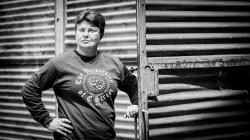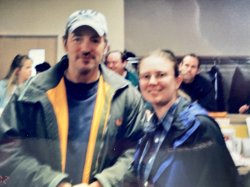Summer Soundtrack: The Boss is Back on Broadway and Montclair State
Professor explores work of Bruce Springsteen in summer course, weighs in on lyric debate
Posted in: Arts, Humanities and Social Sciences

The Boss is back. Back on Broadway. Back blowing up the internet. And back on the summer playlist at Montclair State, where the music, art and life of the superstar is being explored in a class taught by Classics and Humanities professor – and mega fan – Prudence Jones.
Jones has contributed to the scholarly research on the 71-year-old New Jersey rocker, applying her academic expertise of “more ancient stuff” to interpret American pop culture and how Bruce Springsteen’s work reflects the American experience in the late 20th and early 21st centuries.
“My specialization and background is Latin poetry, particularly the Augustan poets,” Jones says. “There’s a fair amount of love poetry, so analyzing lyrics, analyzing poetry, it’s not that big of a jump for me.”
All of which makes Jones particularly qualified to weigh in with a scholarly take on this summer’s debate over the lyrics to Springsteen’s “Thunder Road.” In the weeks since the Boss ushered in the return to live theater with Springsteen on Broadway, fans have taken Twitter by storm arguing about the words “sways” versus “waves” from the opening line, “A screen door slams, Mary’s dress sways” … or to some ears … “Mary’s dress waves.”
Thanks to The New Yorker, fans on July 17 got their answer on what Mary’s dress is doing (it’s “sways,” according to Springsteen’s manager and producer Jon Landau). “That’s the way he wrote it in his original notebooks, that’s the way he sang it on Born to Run, in 1975, that’s the way he has always sung it at thousands of shows, and that’s the way he sings it right now on Broadway. Any typos in official Bruce material will be corrected. And, by the way, ‘dresses’ do not know how to ’wave,’” Landau says in the article.
But a close reading by Jones provides a deeper analysis.
“My opinion is that Bruce has performed it both ways and thus there is no 100% accurate answer,” Jones says. “Being a text person, my approach is to go to the text. The liner notes for Born to Run have ‘waves.’ There are, however, other instances in which liner notes have errors in Springsteen releases, so we can’t rely completely on the printed lyrics. One could argue that if ‘waves’ had been a proofreading error, the lyric would have been corrected on his Greatest Hits. Greatest Hits has ‘waves.’ Lest we think that this is complete confirmation, the liner notes for Live 1975-85 have ‘sways.’ But the version on Live is a different performance of the song on Born to Run and Greatest Hits have the studio recording, while Live has a performance from 10/18/75 at the Roxy.”
Jones clearly is a passionate fan. But it wasn’t until attending graduate school at Harvard that she purchased her first album. She was writing her dissertation on rivers as a symbol of Roman literature, when while browsing in a record store she happened upon an album called The River. With the connection between the title and the themes of her paper, “it seemed like it all was coming together. I was kind of obsessed with that for a while.”
A few years ago, she published an article in Boss: The Biannual Online Journal of Springsteen Studies that looks at Springsteen’s relationship to the American folk tradition and the ways in which he creates a dialogue with that tradition in order to offer his own distinct perspective.
“In the folk tradition, songs evolve and change over time,” Jones says. Applying that to “Thunder Road,” then, “One could ask what was the original conception? Does ‘waves’ pre-date ‘sways’; or vice versa? An early handwritten lyric sheet for ‘Thunder Road’ (written while Bruce was still trying out names for the girl – among them Anne, Chrissie, Christine and Angelina), has ‘sways.’”
The folk tradition is among the themes Montclair State students explore during the popular summer course, Selected Topics: Bruce Springsteen. It’s as introspective as Springsteen is on stage with his Broadway musical and his recent autobiography.
“I ask our students to do a lot,” Jones says. “I give them articles to read and quite a lot of listening. Most of them are already into Springsteen or their parents are really into Springsteen. There’s something in their life that has made them want to understand this better.”
A class sampling includes Springsteen’s social and political works. “We talk about themes that show up in Springsteen lyrics that are also essential in his environment, including the working class as a broad topic and de-industrialization and what was happening in the 1970s. I juxtapose Vietnam and 9/11 as major events that Springsteen responded to in a big way with Born in the U.S.A. and his work with Vietnam veterans and then the Rising tour after 9/11. We talk about Bruce’s reflection on his own celebrity, how he depicts fathers and sons, Catholic imagery and how his faith comes up in his music.”
And they talk about his lyrics. Which brings Jones back to her analysis of “Thunder Road” and the chorus of debate over “sways” and “waves.”
“So there is textual authority for both. The ‘final draft’ in the Born to Run printed lyrics has ‘waves.’ It also has the name ‘Mary’ and we know that Bruce had tried out other names in that spot, so we could say that ‘sways’ was in an early draft and was subsequently edited to ‘waves.’ Unlike the name, however, in subsequent performances of the song, ‘sways’ makes a reappearance although the name never changes once he settles on ‘Mary.’ For that reason, I think that the answer truly is that it is both and which one we get depends on how Bruce recreates the song in each performance.”
The summer class ends August 5. (Maybe Springsteen will join to weigh in.)

Story by Staff Writer Marilyn Joyce Lehren
